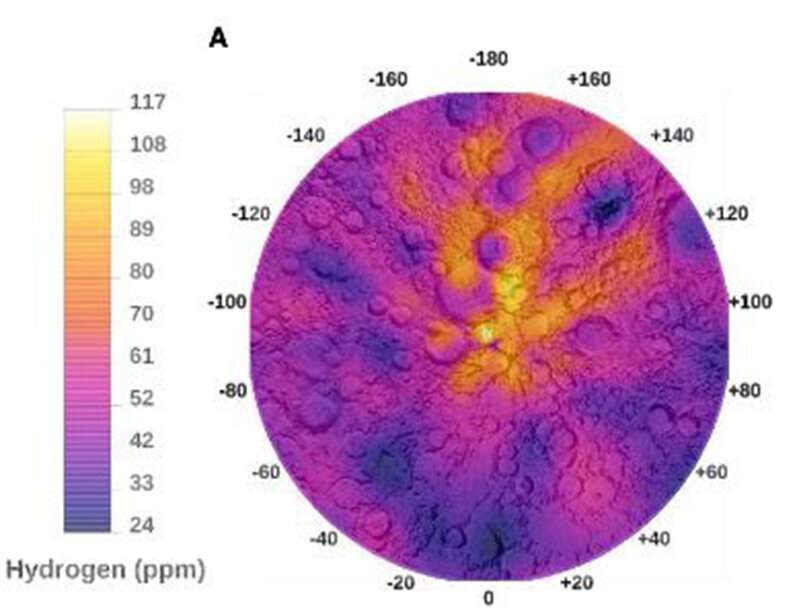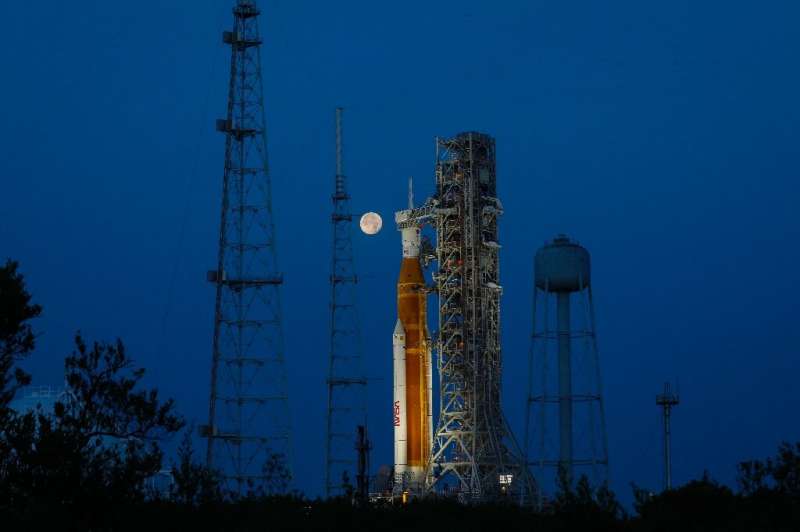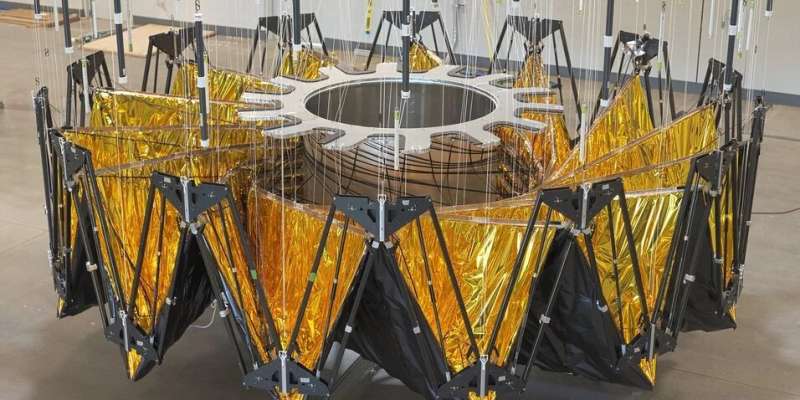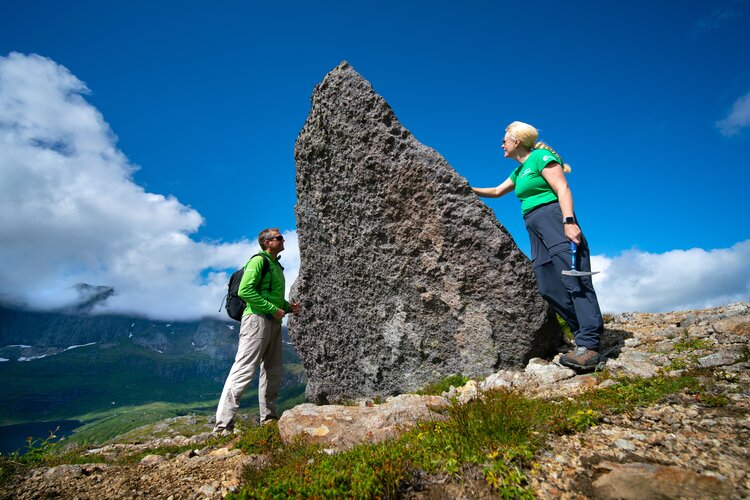Assembling the first global map of lunar hydrogen
Wednesday, 20 July 2022 18:27
Using data collected over two decades ago, scientists from the Johns Hopkins Applied Physics Laboratory (APL) in Laurel, Maryland, have compiled the first complete map of hydrogen abundances on the Moon's surface. The map identifies two types of lunar materials containing enhanced hydrogen and corroborates previous ideas about lunar hydrogen and water, including findings that water likely played a role in the Moon's original magma-ocean formation and solidification.
APL's David Lawrence, Patrick Peplowski and Jack Wilson, along with Rick Elphic from NASA Ames Research Center, used orbital neutron data from the Lunar Prospector mission to build their map. The probe, which was deployed by NASA in 1998, orbited the Moon for a year and a half and sent back the first direct evidence of enhanced hydrogen at the lunar poles, before impacting the lunar surface.
NASA's new Moon rocket to launch as soon as August 29
Wednesday, 20 July 2022 17:10
Mark your calendars: NASA's Artemis program to return to the Moon could launch its first uncrewed test flight as soon as August 29, the agency said Wednesday.
Artemis-1 is the first in a series of missions as the United States seeks to return humans to the Moon, build a sustained presence there, and use the lessons gained to plan a trip to Mars sometime in the 2030s.
Millennium Space reveals results of DARPA’s ‘Red-Eye’ smallsat experiment
Wednesday, 20 July 2022 14:49
The DARPA-funded Red-Eye experiment demonstrated capabilities such as on-board data processing, inter-satellite communications and software-defined radios.
The post Millennium Space reveals results of DARPA’s ‘Red-Eye’ smallsat experiment appeared first on SpaceNews.
Engineer uses ancient art of origami to solve a very modern aerospace problem
Wednesday, 20 July 2022 14:39
If you've ever made an origami paper crane, using folds and creases to transform a square piece of craft paper into the delicate long-necked bird, it may seem odd that those same folding techniques are being used to develop structures used in one of the most advanced areas of modern technology: space missions.
Yet aerospace engineers have turned to the millenary art of origami to solve a serious conundrum: How do you fit massive structures, like shields that can block starlight and sails that can help propel spacecraft, into the significantly smaller rockets that carry these structures into space? While the sizes of each of these structures vary, picture yourself trying to fit a beach umbrella with a 28-meter diameter (about the length of a basketball court) into a minivan.
OneWeb and Hanwha partner to tap Australia’s military broadband market
Wednesday, 20 July 2022 13:50
OneWeb and two subsidiaries of South Korean conglomerate Hanwha Group have partnered to explore the joint provision of connectivity services to the Australian defense market.
The post OneWeb and Hanwha partner to tap Australia’s military broadband market appeared first on SpaceNews.
China prepares to launch Wentian lab module
Wednesday, 20 July 2022 11:22 The combination of China's space station lab module Wentian and a Long March-5B Y3 carrier rocket has been transferred to the launch area, the China Manned Space Agency (CMSA) said Monday.
The CMSA added that the Wentian lab module will be launched in the near future at an appropriate time.
Various launch function checks and joint tests will be carried out as planned before the launc
The combination of China's space station lab module Wentian and a Long March-5B Y3 carrier rocket has been transferred to the launch area, the China Manned Space Agency (CMSA) said Monday.
The CMSA added that the Wentian lab module will be launched in the near future at an appropriate time.
Various launch function checks and joint tests will be carried out as planned before the launc China's newest research lab prepares launch to space
Wednesday, 20 July 2022 11:22 China's Wentian space laboratory and its carrier-a Long March 5B rocket-were moved to a service tower on Monday morning to undergo final tests before their planned flight in the coming days, according to the China Manned Space Agency.
The agency said in a brief statement that prelaunch preparations will begin at the Wenchang Space Launch Center in the southernmost island province of Hainan
China's Wentian space laboratory and its carrier-a Long March 5B rocket-were moved to a service tower on Monday morning to undergo final tests before their planned flight in the coming days, according to the China Manned Space Agency.
The agency said in a brief statement that prelaunch preparations will begin at the Wenchang Space Launch Center in the southernmost island province of Hainan BlackSky to provide advanced AI for space-based dynamic monitoring
Wednesday, 20 July 2022 11:22 BlackSky Technology Inc. (NYSE: BKSY) received a $4.4 million award from the Intelligence Advanced Research Projects Activity (IARPA) to support the second phase of the multi-year Space-based Machine Automated Recognition Technique (SMART) Program. As part of our work, BlackSky created a high-performance MLOps (machine learning operations) framework that was ultimately selected to perform as the core infrastructure to the entire SMART program," said Patrick O'Neil, BlackSky chief innovation officer.
BlackSky Technology Inc. (NYSE: BKSY) received a $4.4 million award from the Intelligence Advanced Research Projects Activity (IARPA) to support the second phase of the multi-year Space-based Machine Automated Recognition Technique (SMART) Program. As part of our work, BlackSky created a high-performance MLOps (machine learning operations) framework that was ultimately selected to perform as the core infrastructure to the entire SMART program," said Patrick O'Neil, BlackSky chief innovation officer. SpaceChain completes EVM blockchain testing in Space
Wednesday, 20 July 2022 11:22 SpaceChain has announced the completion of the testing of the space node it created for Velas Network AG, which is hosted on an LEO satellite and independent of terrestrial networks. The space node is now capable of delivering the full functionalities designed for Velas, including transaction signatures, smart contract deployment, decentralized finance (Defi) activities and non-fungible token (N
SpaceChain has announced the completion of the testing of the space node it created for Velas Network AG, which is hosted on an LEO satellite and independent of terrestrial networks. The space node is now capable of delivering the full functionalities designed for Velas, including transaction signatures, smart contract deployment, decentralized finance (Defi) activities and non-fungible token (N Ericsson, Qualcomm and Thales to take 5G into space
Wednesday, 20 July 2022 11:22 Ericsson, Thales and Qualcomm Technologies, are planning to take 5G out of this world and across a network of Earth-orbiting satellites. After having each conducted detailed research, which included multiple studies and simulations, the parties plan to enter smartphone-use-case-focused testing and validation of 5G non-terrestrial networks (5G NTN).
The result
Ericsson, Thales and Qualcomm Technologies, are planning to take 5G out of this world and across a network of Earth-orbiting satellites. After having each conducted detailed research, which included multiple studies and simulations, the parties plan to enter smartphone-use-case-focused testing and validation of 5G non-terrestrial networks (5G NTN).
The result NASA seeks public's designs to throw shade in space
Wednesday, 20 July 2022 11:22 Searching the universe for Earth-like planets is like looking for a needle in a haystack. To further this exploration, NASA is supporting the early-stage study of a concept for a hybrid observatory that would combine a ground-based telescope with a space-based starshade.
These devices block glare from stars when observing planets outside our solar system, known as exoplanets, from the grou
Searching the universe for Earth-like planets is like looking for a needle in a haystack. To further this exploration, NASA is supporting the early-stage study of a concept for a hybrid observatory that would combine a ground-based telescope with a space-based starshade.
These devices block glare from stars when observing planets outside our solar system, known as exoplanets, from the grou British-built satellite completes line-up for first launch from Spaceport Cornwall
Wednesday, 20 July 2022 11:22 A new research satellite from international engineering firm Rhea Group, built in Oxfordshire by space company Open Cosmos, will be launched from the UK later this year.
Virgin Orbit will launch the 'DOVER' pathfinder satellite from Spaceport Cornwall. The satellite will transmit an innovative new signal, specially designed by engineers at RHEA, to provide data from space that can be used
A new research satellite from international engineering firm Rhea Group, built in Oxfordshire by space company Open Cosmos, will be launched from the UK later this year.
Virgin Orbit will launch the 'DOVER' pathfinder satellite from Spaceport Cornwall. The satellite will transmit an innovative new signal, specially designed by engineers at RHEA, to provide data from space that can be used Dawn Aerospace awarded EU contract for hydrazine-replacement program
Wednesday, 20 July 2022 11:12 Dawn Aerospace has been awarded euro 1.4 million from the European Commission to help develop its transformative 'green', in-space propulsion technology.
The grant will contribute to Dawn's continued investment in hydrazine-replacement technology. The propulsion technology will have the size and performance of a hydrazine-based system, but without the toxicity, supply chain or regulatory
Dawn Aerospace has been awarded euro 1.4 million from the European Commission to help develop its transformative 'green', in-space propulsion technology.
The grant will contribute to Dawn's continued investment in hydrazine-replacement technology. The propulsion technology will have the size and performance of a hydrazine-based system, but without the toxicity, supply chain or regulatory Patent approved for space propulsion system poised to transform orbital space logistics
Wednesday, 20 July 2022 11:12 Orbital logistics and space mining leader TransAstra Corporation has been granted a patent on a solar-thermal rocket engine that will revolutionize the rapidly expanding satellite industry, and accelerate the global space economy.
The company's Omnivore thruster, which powers its Worker Bee space tugs, marks a significant departure from existing rocket propellant systems because it operate
Orbital logistics and space mining leader TransAstra Corporation has been granted a patent on a solar-thermal rocket engine that will revolutionize the rapidly expanding satellite industry, and accelerate the global space economy.
The company's Omnivore thruster, which powers its Worker Bee space tugs, marks a significant departure from existing rocket propellant systems because it operate 

 Image:
Bound up with the Moon
Image:
Bound up with the Moon